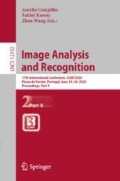Abstract
Breast cancer imaging research has seen continuous progress throughout the years. Innovative visualization tools and easier planning techniques are being developed. Image segmentation methodologies generally have best results when applied to specific types of exams or sequences, as their features enhance and expedite those approaches. Particular methods have more purchase with the segmentation of particular structures. This is the case with diverse breast structures and the respective lesions on MRI sequences, over T1w and Dyn.
The present study presents a methodology to tackle an unapproached task. We aim to facilitate the volumetric alignment of data retrieved from T1w and Dyn sequences, leveraging breast surface segmentation and registration. The proposed method revolves around Canny edge detection and mending potential holes on the surface, in order to accurately reproduce the breast shape. The contour is refined with a Level-set approach and the surfaces are aligned together using a restriction of the Iterative Closest Point (ICP) method. This could easily be applied to other paired same-time, volumetric sequences.
The process seems to have promising results as average two-dimensional contour distances are at sub-voxel resolution and visual results seem well within range for the valid transference of other segmented or annotated structures.
This work was funded by the ERDF - European Regional Development Fund through the Norte Portugal Regional Operational Programme (NORTE 2020), under the PORTUGAL 2020 Partnership Agreement and through the Portuguese National Innovation Agency (ANI) as a part of project BCCT.Plan–NORTE-01-0247-FEDER-01768 and by Fundação para a Ciência e a Tecnologia (FCT) within PhD grants number SFRH/BD/135834/2018 and SFRH/BD/115616/2016.
Access this chapter
Tax calculation will be finalised at checkout
Purchases are for personal use only
Notes
- 1.
BCCT.plan - 3D tool for planning breast cancer conservative treatment - NORTE-01-0247-FEDER-017688.
References
Barber, C.B., Dobkin, D.P., Dobkin, D.P., Huhdanpaa, H.: The Quickhull algorithm for convex hulls. ACM Trans. Math. Softw. 22(4), 469–483 (1996). https://doi.org/10.1145/235815.235821
Canny, J.: A computational approach to edge detection. IEEE Trans. Pattern Anal. Mach. Intell. PAMI–8(6), 679–698 (1986). https://doi.org/10.1109/TPAMI.1986.4767851
Chan, T.F., Vese, L.A.: Active contours without edges. IEEE Trans. Image Process. 10(2), 266–277 (2001). https://doi.org/10.1109/83.902291
Dmitriev, I.D., Loo, C.E., Vogel, W.V., Pengel, K.E., Gilhuijs, K.G.A.: Fully automated deformable registration of breast DCE-MRI and PET/CT. Phys. Med. Biol. 58(4), 1221–1233 (2013). https://doi.org/10.1088/0031-9155/58/4/1221
Doran, S.J., et al.: Breast MRI segmentation for density estimation: do different methods give the same results and how much do differences matter? Med. Phys. 44(9), 4573–4592 (2017). https://doi.org/10.1002/mp.12320
Fashandi, H., Kuling, G., Lu, Y., Wu, H., Martel, A.L.: An investigation of the effect of fat suppression and dimensionality on the accuracy of breast MRI segmentation using U-nets. Med. Phys. 46(3), 1230–1244 (2019). https://doi.org/10.1002/mp.13375
Friedman, J.H., Bentley, J.L., Finkel, R.A.: An algorithm for finding best matches in logarithmic expected time. ACM Trans. Math. Softw. 3(3), 209–226 (1977). https://doi.org/10.1145/355744.355745
Gong, Y.C., Brady, M.: Texture-based simultaneous registration and segmentation of breast DCE-MRI. In: Krupinski, E.A. (ed.) IWDM 2008. LNCS, vol. 5116, pp. 174–180. Springer, Heidelberg (2008). https://doi.org/10.1007/978-3-540-70538-3_25
Hopp, T., Baltzer, P., Dietzel, M., Kaiser, W.A., Ruiter, N.V.: 2D/3D image fusion of X-ray mammograms with breast MRI: visualizing dynamic contrast enhancement in mammograms. Int. J. Comput. Assist. Radiol. Surg. 7(3), 339–348 (2012). https://doi.org/10.1007/s11548-011-0623-z
Klein, A., et al.: Evaluation of 14 nonlinear deformation algorithms applied to human brain MRI registration. NeuroImage 46(3), 786–802 (2009). https://doi.org/10.1016/j.neuroimage.2008.12.037
Kumar, R., et al.: Application of 3D registration for detecting lesions in magnetic resonance breast scans. In: Loew, M.H., Hanson, K.M. (eds.) Medical Imaging 1996: Image Processing, vol. 2710, pp. 646–656. International Society for Optics and Photonics, SPIE (1996). https://doi.org/10.1117/12.237968
Ortiz, C.G., Martel, A.L.: Automatic atlas-based segmentation of the breast in MRI for 3D breast volume computation. Med. Phys. 39(10), 5835–5848 (2012). https://doi.org/10.1118/1.4748504
Song, E., et al.: Hybrid segmentation of mass in mammograms using template matching and dynamic programming. Acad. Radiol. 17(11), 1414–1424 (2010). https://doi.org/10.1016/j.acra.2010.07.008
Xiaohua, C., Brady, M., Lo, J.L.-C., Moore, N.: Simultaneous segmentation and registration of contrast-enhanced breast MRI. In: Christensen, G.E., Sonka, M. (eds.) IPMI 2005. LNCS, vol. 3565, pp. 126–137. Springer, Heidelberg (2005). https://doi.org/10.1007/11505730_11
Zhang, Y., Qiu, Y., Goldgof, D.B., Sarkar, S., Li, L.: 3D finite element modeling of nonrigid breast deformation for feature registration in X-ray and MR images. In: 2007 IEEE Workshop on Applications of Computer Vision (WACV 2007), pp. 38–38, February 2007. https://doi.org/10.1109/WACV.2007.2
Zhang, Z.: Iterative point matching for registration of free-form curves and surfaces. Int. J. Comput. Vis. 13(2), 119–152 (1994). https://doi.org/10.1007/bf01427149
Author information
Authors and Affiliations
Corresponding author
Editor information
Editors and Affiliations
Rights and permissions
Copyright information
© 2020 Springer Nature Switzerland AG
About this paper
Cite this paper
Teixeira, J.F., Bessa, S., Gouveia, P.F., Oliveira, H.P. (2020). A Framework for Fusion of T1-Weighted and Dynamic MRI Sequences. In: Campilho, A., Karray, F., Wang, Z. (eds) Image Analysis and Recognition. ICIAR 2020. Lecture Notes in Computer Science(), vol 12132. Springer, Cham. https://doi.org/10.1007/978-3-030-50516-5_14
Download citation
DOI: https://doi.org/10.1007/978-3-030-50516-5_14
Published:
Publisher Name: Springer, Cham
Print ISBN: 978-3-030-50515-8
Online ISBN: 978-3-030-50516-5
eBook Packages: Computer ScienceComputer Science (R0)

